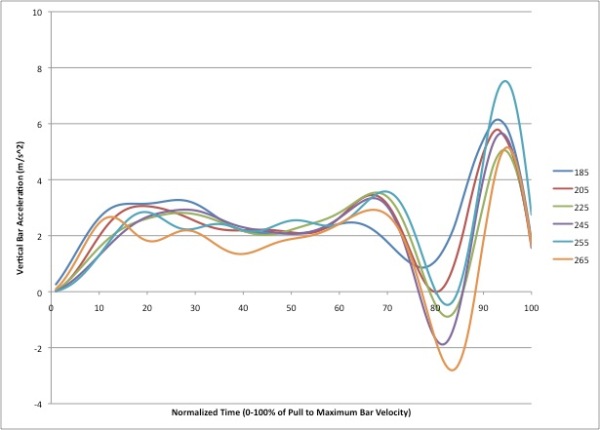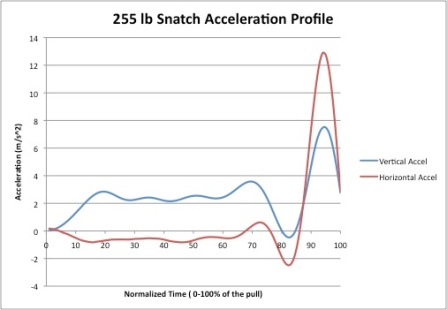Sports technology is a rapidly growing trend and, with Weightlifting/Sport Training being no exception, there are multiple devices on the market to measure barbell acceleration and velocity.
The most classic example is a Tendo unit that measures barbell data using a string attached from the barbell to equipment on the floor. It’s an effective method that is popular in research and weight rooms however, it’s fairly expensive (~$1500) and has involves equipment that can be impractical to use.
A new wave of devices is emerging focusing on ease of use for both equipment set-up and feedback to the user such as the FORM Lifting collar and the PUSH band. These devices use internal accelerometers with couple with software algorithms to identify and quantify barbell motion data. I haven’t tried either device personally but am interested in the concept so I decided to try to make my own.
The Device:
Fabricated Barbell Collar w/ Accelerometer
Two different views of the barbell collar I made with built in sensors. The device is a combination of a microcontroller, accelerometer/gyroscope, Bluetooth transmitter, start button, and a lithium Battery. The device communicated via Bluetooth to my laptop with a script written in Python and the data processing and analysis was done in Matlab.
Sampling rate of the device was ~90 Hz and the data was filtered with a 4th-order butterworth filter at a cutoff frequency of 6 Hz.
Case Study: Barbell Acceleration Over a Snatch Ladder
To test out the device, I used myself as a subject. I’m a fringe national-level athlete and have a good proficiency with the lifts but am by no means elite. Fair warning, and apologies weightlifters, I did this experiment at a CrossFit gym and had to use freedom units (pounds) as opposed to kilos.
For this experiment, I completed one snatch approximately every 90-120 seconds starting at 185 lbs (84 kg) and adding 10 lbs each set. I was successful for each lift until I missed at 265 lbs (120) which is 95% of my best snatch.
The vertical bar velocity profile of selected reps, from lift-off to maximum bar velocity, is shown in the graph below (Figure 1). Each trial was displayed as 0-100% of the total pull time to allow the acceleration patterns to be directly compared.

Immediate Observations Based on Comparison:
- There is a major dip in barbell acceleration at approximately 80% of the pull. This pattern occurs in the majority of lifters, however my dip is significant and as the weight gets heavier, the acceleration becomes more negative. I have long levers and a strong 1st pull, however the transition and second pull are much more difficult for me and it’s evident in the graph. Ideally, the negative acceleration of the barbell would be limited and is clearly a point I need to improve upon.
- The dip in the vertical acceleration changed more as the weight got heavier than the decrease in acceleration from the final extension, indicating that this may be the most critical aspect for me in making heavier lifts.
- The barbell acceleration of my attempt at 255 lbs (115.5 kg) was much higher than any other attempt. The attempt before my at 245 (111 kg) was a near miss and I was much more aggressive at 255. This attempt not only had a much higher peak acceleration but also much less of a dip during the transition phase. Barbell acceleration is critically dependent upon intent, particularly at sub-maximal weights.
Key Take-Aways
- Limiting the negative acceleration of the barbell is critical for a successful lift at heavier weights and a improving the portion of the lift from the knee to kip contact should be a primary focus in training.
- Barbell acceleration is critically dependent upon intent. Particularly at sub-maximal weights. Comparison of many attempts at the same weight may give better insight compared to a progression of higher weights.
- The acceleration pattern in the vertical and horizontal directions (Figure 2) matched what was seen in previous analysis, validating the utility of the instrumented collar. Although the pattern looks correct and is useful for comparing the lifts, further testing is needed to determine exactly how accurate the magnitude of acceleration is.




Could you post the collar schematics and the codes?
LikeLike
Sure. I posted the code files on my Github: https://github.com/jhowenstein. I don’t have a schematic handy but it might be something I add there later.
LikeLike
Thanks, mate. Looking forward to those schematics.
Your posts are very interesting. Keep it up.
LikeLike